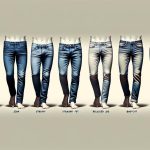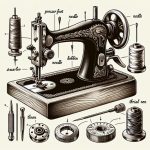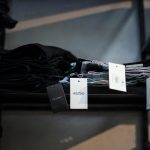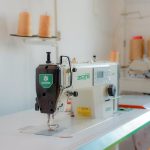If you are a sewing enthusiast, you might have heard about an open toe foot for your sewing machine. But what exactly is an open toe foot?
Simply put, it is a sewing machine presser foot with an opening at the front, allowing you to see the stitching area as you sew. Using an open toe foot can make a significant difference in the quality of your sewing projects.
The clear view of the stitching area allows you to see where you are sewing, making it easier to sew straight and accurately. This is especially useful when sewing tight corners or curves, as it provides better visibility and control.
The open toe foot also allows you to sew thick or bulky fabrics with ease, as it provides enough space for them to pass underneath the foot. In the following sections, you will learn more about the advantages of using an open toe foot and how to use it for different types of projects.
Table of Contents
Definition of an Open Toe Foot
If you wanna get fancy with your sewing projects, you gotta know about the open toe foot – it’s a foot attachment for your machine that allows for greater visibility and precision when sewing! An open toe foot is essentially a sewing machine presser foot that has a wide opening in the middle, giving you a clear view of exactly where you’re stitching.
This is especially helpful when you’re working on intricate designs or when you need to sew along a particular line. One of the biggest advantages of the open toe foot is that it allows you to see exactly where you’re stitching, which means you can be much more precise with your sewing. You can easily follow a seam line or pattern, making sure that you’re sewing exactly where you need to be.
This is especially helpful when you’re working with delicate or intricate fabrics, where even the slightest mistake can ruin your project. Another benefit of the open toe foot is that it allows for greater control over your sewing machine. With a regular presser foot, it can be difficult to see exactly where you’re stitching, which can make it harder to keep your fabric in the right position.
With an open toe foot, you can easily see where you’re stitching, which means you can adjust your fabric as needed to ensure that it stays in the right position. This can help prevent puckering, bunching, or other issues that can arise when you’re sewing with a regular foot.
Advantages of Using an Open Toe Foot
If you’re looking to improve your sewing skills, using an open toe foot can be a game changer. With this type of foot, you’ll enjoy improved visibility as you work, making it easier to keep track of your progress.
Additionally, you’ll find that it’s easier to follow seam lines and prevent fabric from getting caught, helping you create more polished finished products.
Improved Visibility
With an open toe foot, you’ll have better visibility during your sewing projects. This is because the open area in front of the needle allows you to see exactly where your stitches are going. You’ll no longer have to rely on guesswork or constantly stopping to check your progress. This improved visibility can help you achieve more precise and accurate stitching, which is especially important for intricate designs or delicate fabrics.
Here are some ways that improved visibility with an open toe foot can benefit your sewing projects:
- You can easily follow a pattern or template without covering it with your fabric.
- You can see if your fabric is feeding evenly, preventing bunching or uneven seams.
- You can better control the placement and direction of decorative stitching.
- You can catch and fix mistakes more quickly, without having to rip out entire sections of stitching.
By using an open toe foot, you’ll not only have better visibility, but also more control and accuracy in your sewing. It’s a small investment that can make a big difference in the quality of your finished projects.
Easier to Follow Seam Lines
Following the seam lines on your fabric will be a breeze, allowing for smoother and more efficient sewing. With an open toe foot for your sewing machine, you’ll have a clear view of the needle and the fabric, making it easier to follow the seam lines accurately.
The open design of the foot also allows for better control of the fabric, preventing it from shifting or bunching up during sewing. Additionally, an open toe foot gives you the advantage of being able to see the stitching as it happens.
This makes it easier to detect any mistakes or uneven stitches, allowing you to correct them immediately. With better visibility and control, you can achieve more professional-looking results, even if you’re a beginner.
So, if you want to take your sewing skills to the next level, consider using an open toe foot for your sewing machine.
Prevents Fabric from Getting Caught
You’ll love how smoothly your fabric will glide through the presser foot, without any fear of it getting caught or stuck. An open toe foot for a sewing machine is designed to prevent fabric from getting caught in the machine.
The open toe design allows you to see exactly where you’re stitching, so you can avoid any potential snags or tangles. Not only does an open toe foot prevent fabric from getting caught, but it also makes it easier to sew around curves and corners.
The open toe design gives you more visibility, so you can follow the seam line more accurately. This means you can achieve a more professional-looking finish, even if you’re a beginner. With an open toe foot, you can sew with confidence, knowing that your fabric will glide smoothly through the machine and come out looking beautiful.
How to Install an Open Toe Foot
First, take your fabric and place it underneath the presser foot, making sure to align it with the needle.
Next, loosen the screw on the presser foot holder and remove the current foot. Take your open toe foot and slide it onto the presser foot holder, making sure it clicks into place. Tighten the screw to secure the foot onto the holder.
Once the foot is installed, adjust the needle position if needed. Lower the presser foot and begin sewing. The open toe design allows for better visibility of the stitching area, making it easier to sew accurately. Keep an eye on the fabric as you sew, making any necessary adjustments to ensure it stays aligned.
When finished, remove the fabric and turn off the sewing machine. Take off the open toe foot by loosening the screw and sliding it off the presser foot holder. Store the foot in a safe place until you need it again.
With a little practice, installing and using an open toe foot will become second nature and help you achieve more precise stitching in your sewing projects.
Types of Projects That Benefit from an Open Toe Foot
If you’re working on a project that requires precise stitching along curves and edges, using an open toe foot can greatly improve your accuracy and make the process easier. This type of foot allows for better visibility as it features an open front that gives you an unobstructed view of your sewing area. As a result, you can easily follow your stitch lines and make adjustments as needed.
Here are some types of projects that can benefit from using an open toe foot:
-
Quilting: When quilting, you need to stitch along multiple layers of fabric and batting. An open toe foot can help you see where your needle is going and prevent puckering or bunching of the layers. It also allows you to pivot at corners and curves without losing your stitch line.
-
Applique: Applique involves sewing a piece of fabric onto a larger background fabric. An open toe foot can help you stitch close to the edges of the applique without accidentally catching the surrounding fabric. This is especially important when working with intricate designs or small pieces.
-
Free-motion embroidery: Free-motion embroidery involves moving the fabric under the needle to create a design. An open toe foot can give you better control over your movements and allow you to see how your stitches are forming. It also prevents fabric from getting caught under the foot, which can lead to uneven stitches or thread breakage.
Overall, using an open toe foot can make your sewing projects more precise and enjoyable. Whether you’re quilting, appliqueing, or doing free-motion embroidery, this type of foot can help you achieve professional-looking results. So, if you haven’t tried it yet, give it a go and see the difference it can make!
Tips for Using an Open Toe Foot
When using an open toe foot on your sewing machine, there are a few tips to keep in mind for optimal results.
Firstly, you should adjust the needle position to ensure that your stitching is as precise as possible.
Secondly, choosing the right stitch length can prevent bunching or puckering of fabric.
Lastly, when sewing with multiple layers, take care to feed the layers evenly through the foot to avoid any shifting or distortion.
Adjusting the Needle Position
To adjust the needle position on your sewing machine for your open toe foot, simply move the needle to the desired position using the machine’s controls. Most machines have a knob or lever that allows you to move the needle left or right. This is especially useful when working with a specific seam allowance or when trying to get as close to the edge of the fabric as possible.
Make sure to test the needle position on a scrap piece of fabric before starting your project. You want to make sure the needle is in the correct position for your desired outcome. It may take some trial and error to find the perfect needle position, but with practice, you’ll be able to adjust it quickly and easily.
By taking the time to adjust the needle position, you’ll be able to achieve more precise stitching with your open toe foot.
Choosing the Right Stitch Length
Picking the proper stitch length can have a huge impact on the final outcome of your project. Stitch length refers to the distance between each stitch, and it can affect the durability, appearance, and flexibility of your fabric. Choosing the right stitch length depends on the type of fabric you are using, the purpose of your project, and the type of stitch you are using.
To help you choose the right stitch length, here is a table that shows the recommended stitch lengths for different types of fabrics and stitches:
| Fabric Type | Stitch Type | Recommended Stitch Length |
|---|---|---|
| Light-weight fabrics (such as silk, chiffon, and organza) | Straight stitch | 2.0-2.5 mm |
| Medium-weight fabrics (such as cotton, linen, and wool) | Straight stitch | 2.5-3.0 mm |
| Heavy-weight fabrics (such as denim, canvas, and upholstery) | Straight stitch | 3.5-4.0 mm |
| Knit fabrics (such as jersey, spandex, and fleece) | Zigzag stitch | 2.5-3.0 mm |
| Decorative stitches (such as satin stitch and applique) | Various stitches | Varies based on desired effect. |
Remember, these are just guidelines and you should always test your stitch length on a scrap piece of fabric before starting your project. By choosing the right stitch length, you can ensure that your seams are strong, your fabric looks neat and tidy, and your project looks professional.
Sewing with Multiple Layers
Mastering sewing with multiple layers can be challenging, but don’t let frustration hold you back from creating the perfect project. When sewing with multiple layers, it’s important to choose the right needle and thread for the job.
A heavier weight fabric or several layers of fabric may require a thicker needle and stronger thread. Be sure to test your needle and thread on a scrap piece of fabric before starting your project to ensure that they can handle the thickness and weight of your materials.
Another important factor to consider when sewing with multiple layers is the presser foot. An open toe foot is a great option for sewing thicker fabrics or multiple layers because it allows for better visibility and control.
The open toe design allows you to see exactly where the needle is going and helps prevent any shifting or bunching of the fabric. With the right needle, thread, and presser foot, you can confidently tackle any project with multiple layers and achieve professional-looking results.
Maintenance and Care for Your Open Toe Foot
Now that you’ve learned how to use your open toe foot, it’s important to take good care of it. This includes regular cleaning and lubrication, which will help maintain its performance and prolong its lifespan.
Additionally, storing your open toe foot properly will prevent damage and ensure that it’s ready to use whenever you need it.
Cleaning and Lubrication
To keep your sewing machine running smoothly, it’s important to regularly clean and lubricate the open toe foot. Here are some tips to help you do so:
-
Use a soft-bristled brush to remove any dust or debris from the open toe foot. This will prevent any buildup from interfering with the foot’s movement.
-
Apply a small amount of sewing machine oil to the open toe foot’s joints and moving parts. Be sure to wipe away any excess oil to prevent it from getting on your fabric.
-
Check your sewing machine’s manual for any specific instructions on cleaning and lubricating the open toe foot. Some machines may require a different type of oil or cleaning method.
By taking the time to properly care for your open toe foot, you can ensure that it will continue to function effectively and help you create beautiful, professional-looking stitches.
Storage
Properly storing your equipment is crucial to maintaining its longevity and preventing any damage or wear and tear over time. When it comes to sewing machines, it’s important to store them in a safe and dry place, away from any potential hazards or moisture. Ideally, you should cover your machine with a dust cover or cloth to protect it from dust, dirt, and other debris that can accumulate over time.
In addition to covering your sewing machine, it’s also important to store it with its accessories and components properly organized. This not only helps to prevent any loss or damage to the parts, but also makes it easier to find and use them when you need them. To help you get started, here is a simple table to reference when storing your open toe foot for your sewing machine:
| Item | Storage |
|---|---|
| Open toe foot | Store in a separate container or bag to prevent damage or loss |
| Dust cover or cloth | Cover the machine to protect it from dust and debris |
| Other accessories | Store in a separate container or bag, clearly labeled and organized |
| Sewing machine | Store in a dry and safe place, preferably with a cover or cloth |
By following these simple tips and storing your sewing machine properly, you can help to ensure that it remains in good condition and ready for use whenever you need it.
- Planning Your Project: How Much Fabric to Make a Laptop Case? - June 25, 2025
- Never Buy Too Little: How Much Fabric for Two Standard Pillow Cases - June 25, 2025
- Fabric Requirements for a Body Pillow Case: A Complete Guide - June 25, 2025






